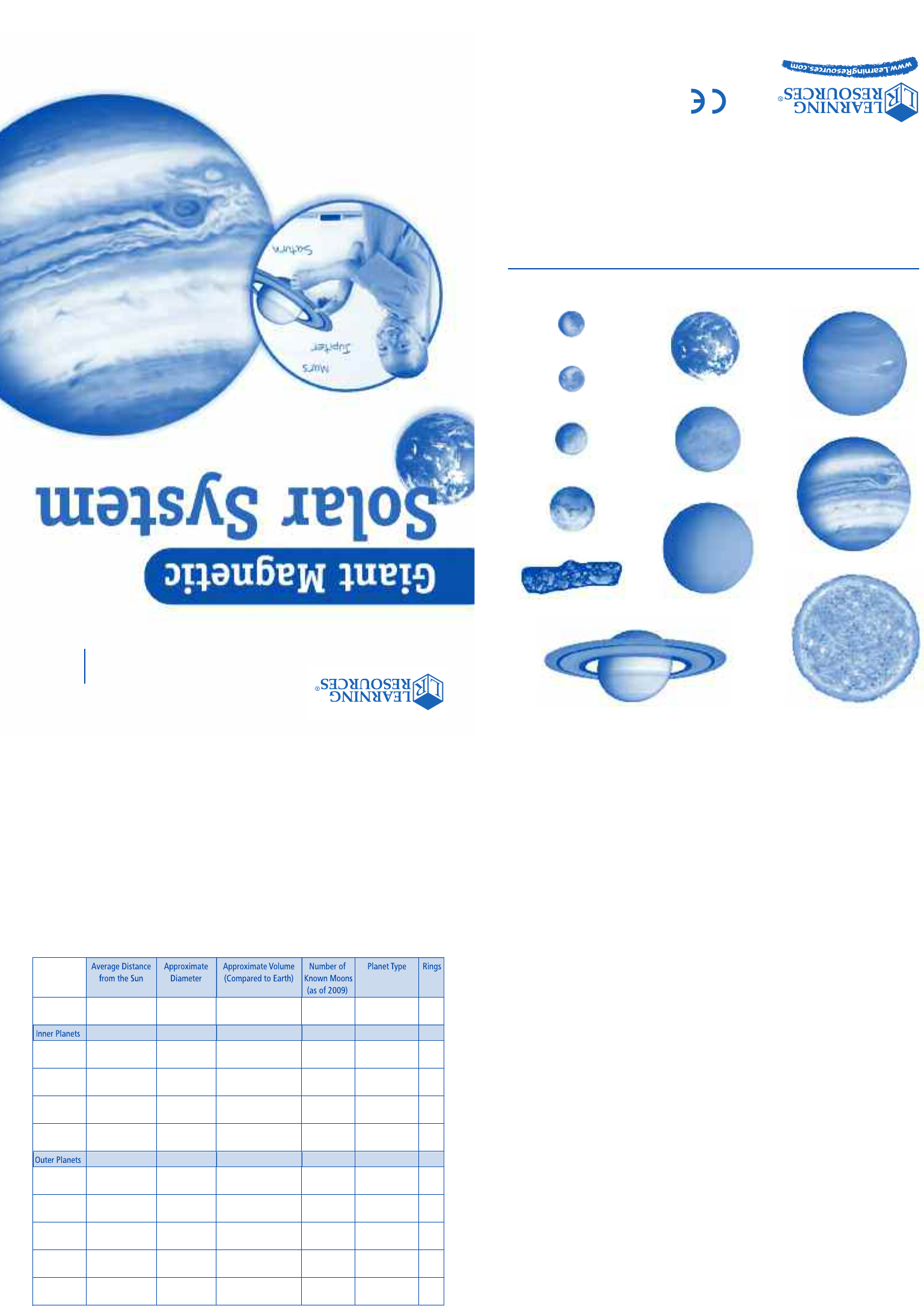
© Learning Resources, Inc., Vernon Hills, IL (U.S.A.)
Learning Resources Ltd., King’s Lynn, Norfolk (U.K.)
P
lease retain our address for future reference.
Made in China. LRM6040-GUD
Fabriqué en Chine. Informations à conserver.
Made in China. Bitte bewahren Sie unsere
A
dresse für spätere
Nachfragen auf.
Hecho en China. Conservar estos datos.
V
isit our website to write a product review
or to find a store near you.
LER 6040
Ages
5+
Grades
K
+
Look for these other great products from
L
earning Resources
®
:
LER 2434 Giant Inflatable Solar System
L
ER 6041 Giant Magnetic Frog Life Cycle
LER 6042 Giant Magnetic Insect
LER 6044 Double-Sided Magnetic Human Body
LER 6366 Giant Magnetic Base Ten Block Demonstration Set
12-Piece set includes:
Sun Asteroid Belt
Mercury Jupiter
V
enus Saturn
Earth Uranus
Earth’s Moon Neptune
Mars Pluto-dwarf planet
Make your whiteboard
come alive with science!
Average Distance Approximate ApproximateVolume Number of PlanetType Rings
from the Sun Diameter (Compared to Earth)
Known Moons
(as of 2009)
Sun n/a
1,392,000 km About 1,300,000 times
(864,000 miles) greater than Earth's
n/a n/a n/a
Inner Planets
Mercury
5.79 million km 4,879 km
(35 million miles) (3,032 miles)
About 6% of Earth's 0 Rocky/Terrestrial No
Venus
108 million km 12,104 km
(67 million miles) (7,521 miles)
About 86% of Earth's 0 Rocky/Terrestrial No
Earth
149 million km 12,756 km 1.08 x 1012 km3
(93 million miles) (7,926 miles) (261 billioncubicmiles)
1 Rocky/Terrestrial No
Mars
227 million km 6,792 km
(141 million miles) (4,222 miles) About 15% of Earth's
2 Rocky/Terrestrial No
Outer Planets
Jupiter
778 million km 142,984 km About 1,316 times
(483 million miles) (88,846 miles) greater than Earth's
63 Mostly Gas Yes
Saturn
1.4 trillion km 120,536 km About 752 times
(886 million miles) (72,367 miles) greater than Earth's
60 Mostly Gas Yes
Uranus
2.8 trillion km 51,118 km About 67 times
(1.78 trillion miles) (31,518 miles) greater than Earth's
27 Mostly Gas Yes
Neptune
4.5 trillion km 49,528 km About 54 times
(2.79 trillion miles) (30,601 miles) greater than Earth's
13 Mostly Gas Yes
Pluto 5.9 trillion km 2,390 km Less than 1%
(Dwarf Planet) (3.67 trillion miles) (1,491 miles) of Earth's
3 Mostly Gas & Ice No
Key Vocabulary
Asteroid large space rock covered with craters; most asteroids orbit the
sun in the asteroid "belt" located between Mars and Jupiter; asteroids
can be as small as a few hundred meter wide to as big as 965 km
(600 miles) wide
dwarf planet object orbiting the sun that is big and heavy enough to
resemble a planet, but not quite big enough to have its own clear orbit
around the sun; Pluto is a dwarf planet
galaxy grouping of billions of stars held together by gravity whose shapes
include spiral, elliptical, and irregular; our solar system is part of the spiral-
shaped Milky Way Galaxy
gas planet sometimes called a Jovian, or giant, planet, which is made of
mostly gas and lacks a clearly defined surface; includes Jupiter, Saturn,
Neptune, and Uranus
inner planets the first four planets that orbit the sun before the asteroid
belt; includes Mercury, Venus, Earth, and Mars
moon a natural satellite orbiting a planet
orbit elliptical path followed by planets and other space objects as they
revolve around other objects of greater gravity, like the sun
outer planets the five planets that orbit the sun outside the asteroid belt;
includes Jupiter, Saturn, Neptune, Uranus, and Pluto (dwarf planet)
rocky planet solid-surfaced planet that is also called a terrestrial planet;
includes Mercury, Venus, Earth, and Mars
solar system consists of a star and all the objects orbiting that start along
with any other material contained in the system; our solar system includes
the sun, its eight planets, their moons, and all the other celestial bodies and
materials that orbit the sun, including dwarf planets, comets, and asteroids
star stars are giant burning ball of hydrogen and helium gas that give off
both light and heat; red and orange stars are cooler than the hotter white
or blue colored stars; the sun, although large to everyone on Earth, is
considered to be an average star in size (about 1,392,000 km or 864,000
miles across).
Turn your whiteboard into an out-of-this-world adventure with this colorful
set of magnets. Go beyond decoration and use the magnets for discussion
and sorting activities such as planet order, size, planet type, and more!
Care Instructions
Write on magnets with a dry or wet-erase marker for multiple uses. Test
your marker on the corner of a magnet to make sure marks erase. Erase
wet-erase marks with a damp cloth. Do not saturate the magnet. Too much
water will damage the product. Do not bend the magnets as this will
decrease their magnetism.
Solar System Facts
2
3
Sun
Jupiter
Neptune
Saturn
Uranus
Earth
Venus
Mars
Astroid Belt
Mercury
Moon
Pluto
